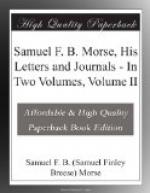The first of the three to enter into the history of the telegraph was Leonard D. Gale, who, in 1836, was a professor in the University of the City of New York, and he has given his recollections of those early days. Avoiding a repetition of facts already recorded I shall quote some sentences from Professor Gale’s statement. After describing the first instrument, which he saw in January of 1836, he continues:—
“During the years 1836 and beginning of 1837 the studies of Professor Morse on his telegraph I found much interrupted by his attention to his professional duties. I understood that want of pecuniary means prevented him from procuring to be made such mechanical improvements, and such substantial workmanship, as would make the operation of his invention more exact.
“In the months of March and April, 1837, the announcement of an extraordinary telegraph on the visual plan (as it afterwards proved to be), the invention of two French gentlemen of the names of Gonon and Servell, was going the rounds of the papers. The thought occurred to me, as well as to Professor Morse and some others of his friends, that the invention of his electro-magnetic telegraph had somehow become known, and was the origin of the new telegraph thus conspicuously announced. This announcement at once aroused Professor Morse to renewed exertions to bring the new invention creditably before the public, and to consent to a public announcement of the existence of his invention. From April to September, 1837, Professor Morse and myself were engaged together in the work of preparing magnets, winding wire, constructing batteries, etc., in the University for an experiment on a larger, but still very limited scale, in the little leisure that each had to spare, and being at the same time much cramped for funds....
“The latter part of August, 1887, the operation of the instruments was shown to numerous visitors at the University....
“On Saturday, the 2d of September, 1837, Professor Daubeny, of the English Oxford University, being on a visit to this country, was invited with a few friends to see the operation of the telegraph, in its then rude form, in the cabinet of the New York University, where it had then been put up with a circuit of seventeen hundred feet of copper wire stretched back and forth in that long room. Professor Daubeny, Professor Torrey, and Mr. Alfred Vail were present among others. This exhibition of the telegraph, although of very rude and imperfectly constructed machinery, demonstrated to all present the practicability of the invention, and it resulted in enlisting the means, the skill, and the zeal of Mr. Alfred Vail, who, early the next week, called at the rooms and had a more perfect explanation from Professor Morse of the character of the invention.”
It was Professor Gale who first called Morse’s attention to the discoveries of Professor Joseph Henry, especially to that of the intensity magnet, and he thus describes the interesting event:—




